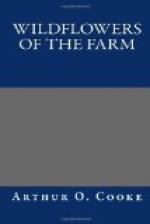The Gorse flowers are beautiful and their scent is sweet. As to gathering them, however, there is a terrible difficulty. The flowers grow among long sharp spikes which cover the stems closely; you would almost as soon gather nettles! There are very few real leaves, and they are small and not easily seen; but the thorns are beautiful to look at, if not to touch—they are such a rich dark green.
Nor is Gorse a useless plant. If the prickly stems are bruised or mashed a little they form a fodder which animals like. Indeed, a pony near us seems to enjoy them as they are; he is tearing off and eating piece after piece from a Gorse bush. His mouth must be less tender than ours!
Later in the summer we visit the Chase again to find some flowers that were not out in May. On our way we pass a potato field in blossom—a very pretty sight. These blossoms are a palish purple, but sometimes the potato flowers are white.
The Hairbell is a flower which we shall now find on the Chase—a great contrast to the stout and thorny bush of Gorse. The Hairbell’s stem is almost as slender as a thread, although it stands upright. Each blossom is a dainty little blue bell of five petals. White blossoms are sometimes found, but not often.
There are leaves as well as flowers on the stem. Growing from the lower part of the stem, close to the ground, we may perhaps find some broader, rounder leaves; perhaps not, however, for these lower leaves soon wither and die away.
[Illustration: HAIRBELL.]
The Hairbell loves to grow where there is fresh pure air. Here on the Chase we are high up; it has been a long steep climb from Willow Farm, and we are more than five hundred feet above sea level. Far below us, a few miles away, we see a broad river on which steamers and sailing-ships are passing up and down. Away to the west is the sea, from which a breeze is nearly always blowing across the Chase. No wonder that the little Hairbell loves the spot.
We have found a yellow flower and a blue one on the Chase, and now we have not far to look for something red. Here is a clump of Heath or Ling, and not far off a patch of Heather too. We must be careful to distinguish Heath from Heather; let us look at the Heath first.
On the Heath, as on the Hairbell, we find bell-shaped flowers; but the blossoms of the Heath are very small, and grow from a tough woody stem. They are a reddish-purple. On little side branches growing from the stems are the very tiny leaves. The whole plant is low, bushy, and spreading.
[Illustration: HEATH AND HEATHER.]
The flowers of the Heather are rather larger, deep crimson in colour, and grow in clusters. On the flower stems grow very small narrow leaves; there are generally three of them together and they do not grow so thickly as the leaves of Heath. Among these leaves are some that are made up of several leaflets.




